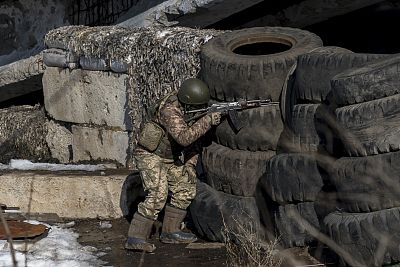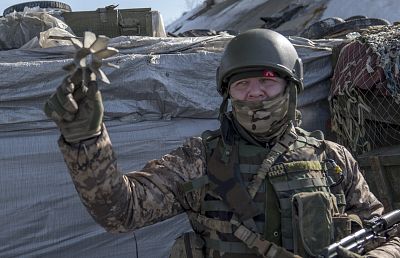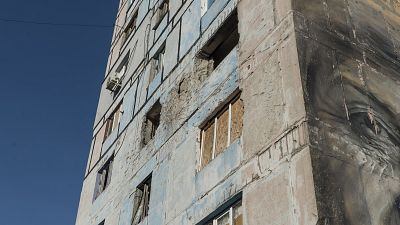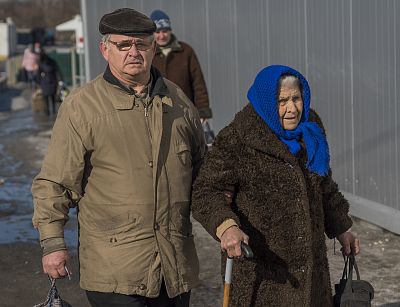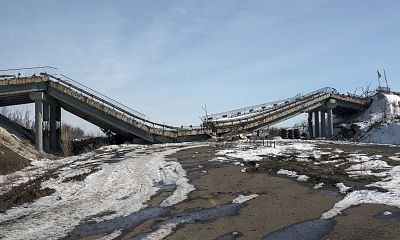What started as a seemingly internal squabble has become one of the most dangerous potential flashpoints between Russia and the United States.
AVDIIVKA, Ukraine — In the forgotten trenches of Europe, war is grinding into its sixth year.
Soldiers trudge along a snowy track lined with shell holes now covered in ice. They sprint across a gully to avoid enemy snipers and make it to the relative safety of trenches that snake through a scarred landscape of barren trees and shattered buildings. Makeshift walkways of scrap wood do little to keep out the mud that is everywhere.
Through a small opening in a bunker, a soldier peers out into no-man's land as a heavy gun stands at the ready nearby. The enemy is just 300 yards away and the sound of artillery can be heard over the trench walls.
The crack of a sniper rifle rings out, but the soldiers don't react.
They've been fighting here too long and the fire is too far away — this time.
For more on this story, watch NBC's "Nightly News" tonight at 6:30 p.m. ET.
The war in Eastern Ukraine is frozen. And what started as a seemingly internal squabble has become one of the most dangerous potential flashpoints between Russia and the United States.
Some 13,000 people have been killed in the fighting since Russian-backed separatists declared independence and established their own "People's Republics" in April 2014, according to the United Nations.
More than 2,000 were killed last year alone, despite a ceasefire.
Ukraine is not yet a member of NATO, but it aspires to join the defense pact. Were that to happen, it could be a red line for Russian President Vladimir Putin and turn this regional conflict into a far larger war.
All this in a conflict that is technically under a ceasefire deal.
Clearly, those agreements brokered by diplomats and peacekeepers mean little for soldiers on the frontline, however.
Ukrainian officer Dmitri Kebtz has been fighting for three years. With his graying beard and AK-47 rifle slung over his shoulder, he looks every bit the part of the battle-hardened soldier. But this is not where he wants to be.
"I don't like this," he says. "I'm civil. But I feel if I don't come to the army, who is coming?"
Where once rockets and tank shells shattered apartment blocks and rural villages, snipers are now the greatest enemy.
"You can hide from artillery," Kebtz says. "But snipers see your face."
It is a constant worry on the frontline, a refrain heard at every turn and gap between cover: Stay low, move fast, spread out.
Kebtz claims the highly trained snipers — and their commanders — are in fact from the Russian army, not local separatists.
At first Russia denied that it was playing any role in the conflict, but the casualties sent home and advanced weapons systems spotted in the area soon lifted the veil on their involvement.
It is estimated hundreds of Russians have died fighting in Ukraine, but the real number is hard to verify. Those killed in the conflict aren't named publicly — it's classified information under Russian law.
The Ukrainians have their share of outside help as well. The U.S. Army operates a training mission on the ground, though thousands of miles from the fighting. And just last year the U.S. began supplying Ukraine with Javelin anti-tank missiles. Meanwhile, President Donald Trump's relationship with NATO continues to be on edge, with his threats to pull out of the agreement alarming lawmakers in the U.S.
In November the conflict threatened to erupt when Russian forces shot at and seized three Ukrainian vessels off the coast of Crimea, prompting Ukraine to declare martial law.
Caught in the middle are the civilians. More than 2 million Ukrainians have been displaced by the war, according to the United Nations.
Those who remain in the separatist territories struggle to get by. Utilities and alcohol are cheap, says one resident of separatist-held Horlivka, but quality goods are impossible to find.
Jobs are few and retirees still rely on their Ukrainian pensions. Under law they must collect them in person every month, meaning a long and dangerous journey across the frontline at five official crossing points.
On a good day it can take eight hours to make it past the separatist checkpoints if they are willing to pay a bribe. If not, the wait can last as long as four days.
Once on the government-held side they are searched by the military, looking for separatists or contraband.
In the small town of Zaitjeve not far from the front, Taisiya, 90, chatted with a group of international monitors on a coffee break.
"This is not a war," she said, boasting of her days supporting the Ukrainian partisans fighting against Nazi Germany in World War II. "We survived hunger and the war. We survived everything."
World
She said she didn't understand the point of this conflict that is once again bringing chaos to her rural world.
"We gave life to the next generation and they're not paying us back," she said.
Back at the front, Dimitri Kebtz takes a different view.
"We are democratic European people," he said. "I know in the U.S. freedom is real. I want the same freedom in Ukraine. Same democracy, same system. I don't want the system of Russia in this place."
That system could not be closer. Just behind the trenches is the road that once was the main highway connecting Ukraine's capital of Kiev and the Russian city of Rostov-on-Don. It is now eerily quiet and riddled with the debris of war.
Even if a Ukrainian wanted to take this road to Russia, they would not get far. Separatists blew up an overpass when they retreated three years ago.
Now the rubble provides good cover for Kebtz and his fellow soldiers.
Grabbing a clump of Ukrainian mud from the trench wall, he holds it tightly in his fist. "It's my country. It's my earth. It's mine."
"I am dog and Russia is elephant," he says." But we will fight."












